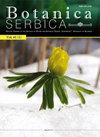亚高山地衣和山地地衣群提取物的抗氧化和抗菌活性的变化
IF 1.1
4区 生物学
Q4 PLANT SCIENCES
引用次数: 0
摘要
地衣是在大多数环境中发现的超有机共生系统。环境因素,如温度、海拔、降水、紫外线照射或病原体,显著影响地衣的生理,从而影响其次生代谢。来自不同环境的同一种地衣的菌体在次生代谢物和保护色素的产生方面表现出差异。本研究选取了两个不同海拔、温度和降水生境的岛屿地衣种群。然后比较了它们的抗氧化和抗菌活性。地衣菌体分为两部分:上半部分暴露在光照下,下半部分隐藏在广泛的辐射下。结果表明,来自恶劣高山环境的菌体具有较强的DPPH自由基清除能力,对氧化应激具有较强的耐受性。另一方面,来自温和山地环境的个体通常产生更多的次生代谢物,导致提取物的抗菌活性增加。含有富马原心酸和副次酸的岛草提取物对革兰氏阳性菌(如金黄色葡萄球菌)有抑制作用,对革兰氏阴性菌(如大肠杆菌)有较低的抑制作用。本文章由计算机程序翻译,如有差异,请以英文原文为准。
An insight into the variation of the antioxidative and antibacterial activity of extracts from populations of the subalpine and montane lichen Cetraria islandica
Lichens are supra-organismal symbiotic systems found in most environments. Environmental factors, such as temperature, altitude, precipitation, UV irradiation, or pathogens, significantly influence the physiology of lichens, and thus their secondary metabolism. The thalli of the same lichen species from different environments exhibit variation in the production of secondary metabolites and protective pigments. We selected two populations of the lichen Cetraria islandica from habitats differing in altitude, temperature, and precipitation. Then we compared their antioxidative and antibacterial activity. The lichen thalli were divided into two parts: the upper parts were exposed to light and the lower parts hidden from extensive radiation. The results show that the thalli from harsh alpine environments have higher 2,2-diphenyl-1-picryl-hydrazyl-hydrate (DPPH) radical scavenging activity suggesting better tolerance to oxidative stress. On the other hand, the individuals from milder montane environments generally produce more secondary metabolites, leading to increased antibacterial activity of the extracts. The extracts of C. islandica containing fumarprotocetraric and paraconic acids exhibit inhibitory effects against gram-positive bacteria (e.g. Staphylococcus aureus) and some lower activity against gram-negative bacteria (e.g. Escherichia coli).
求助全文
通过发布文献求助,成功后即可免费获取论文全文。
去求助
来源期刊

Botanica Serbica
Agricultural and Biological Sciences-Plant Science
CiteScore
1.40
自引率
12.50%
发文量
17
审稿时长
34 weeks
期刊介绍:
Botanica Serbica publishes original research papers on all aspects of plant, fungal and microbial biology research including the disciplines of microbiology, mycology, lichenology, bryology, flora, vegetation, biogeography, systematics, taxonomy, plant biotechnology, plant cell biology, plant ecology, environmental plant biology, forestry, genomics, horticulture, limnology, metabolomics, molecular biology, proteomics, virology, plant conservation and protection, and wildlife and ecosystem management.
 求助内容:
求助内容: 应助结果提醒方式:
应助结果提醒方式:


